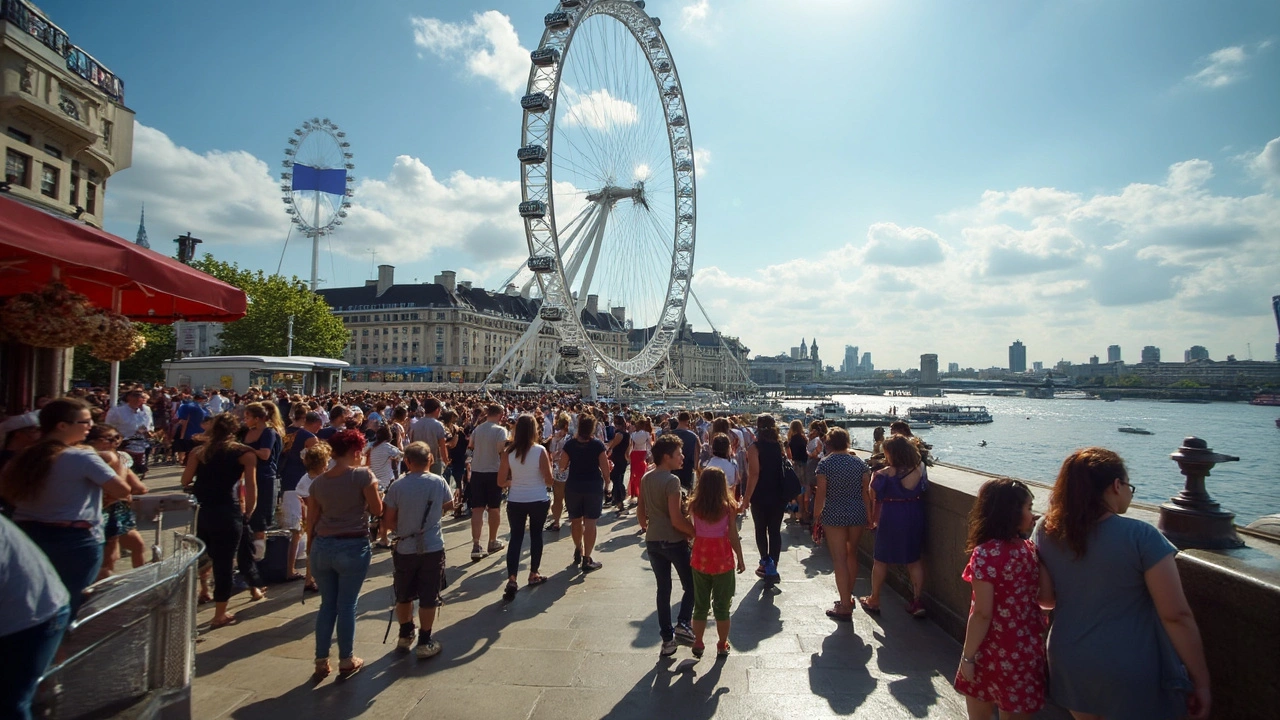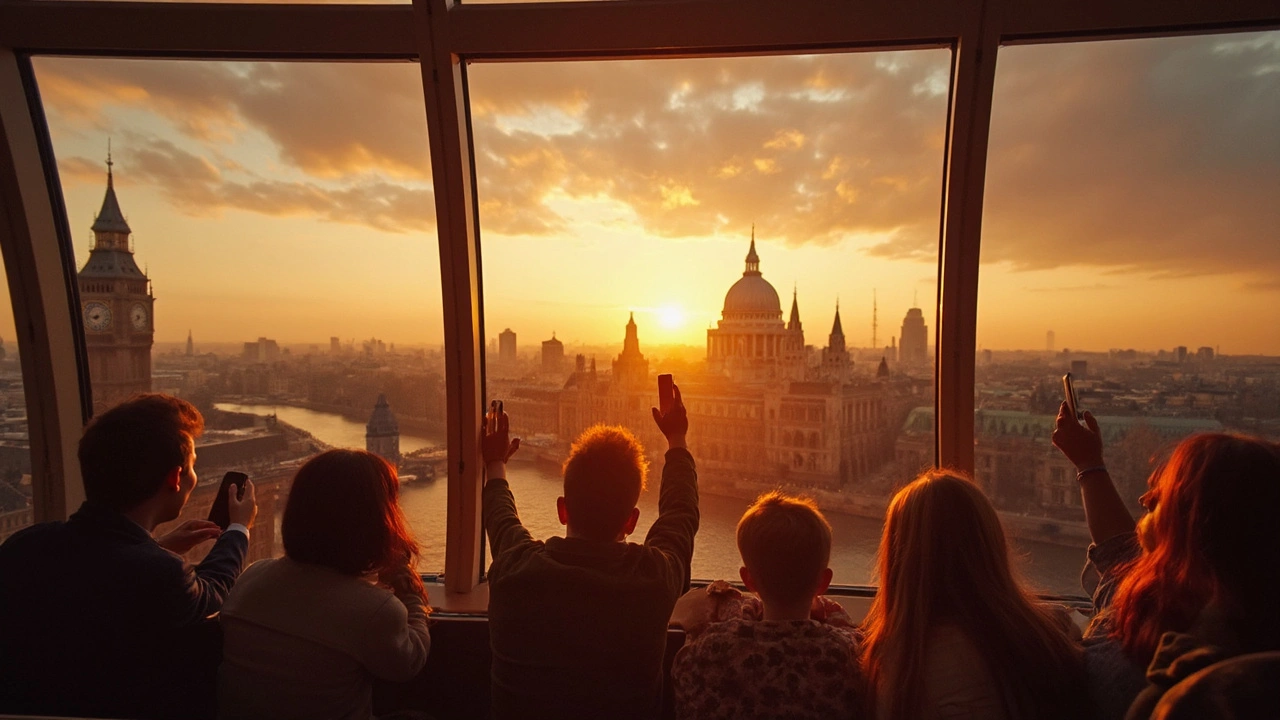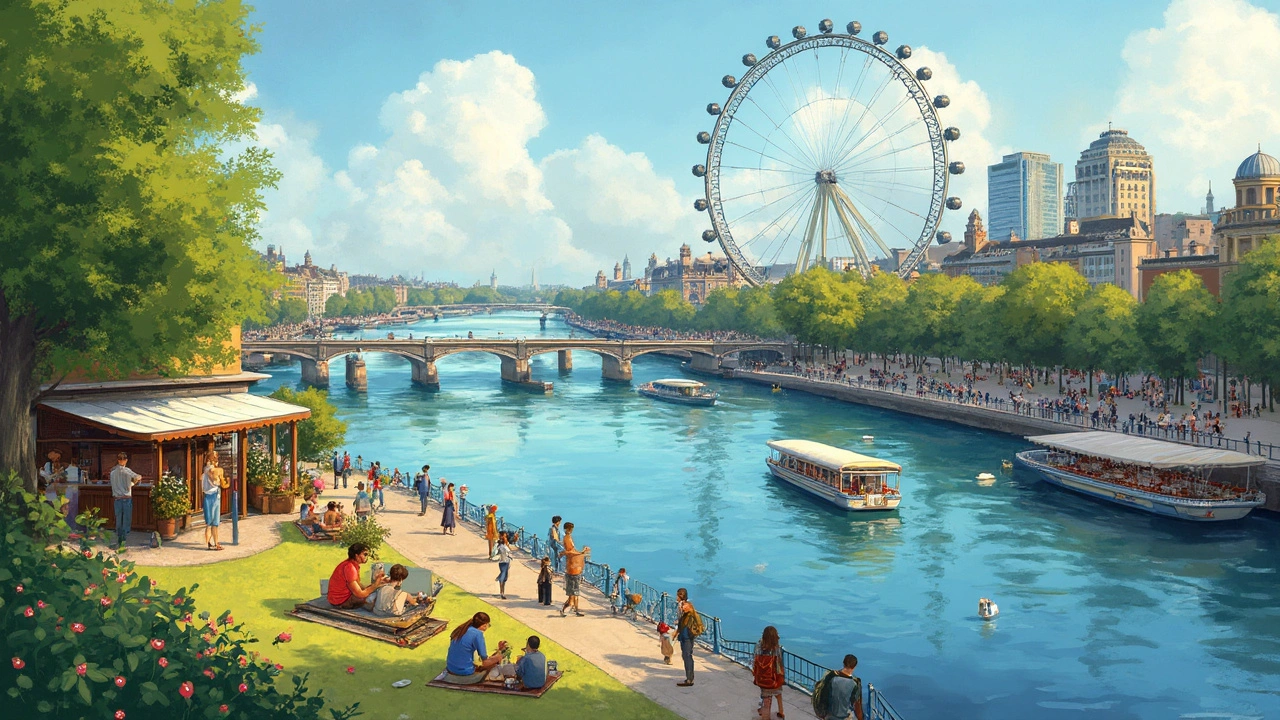
If you’ve spent any time in London, you’ve seen that massive wheel on the South Bank—the London Eye. It’s hard to miss, spinning slowly above the Thames, packed with people snapping photos and peering out over the city. But is it actually worth it? What’s it really like up there—and how do you dodge the common hassles?
The London Eye gets busy. Local Londoners know weekends and school holidays mean long queues, especially on bright days when the city feels suddenly Mediterranean. Advance booking helps, but there’s more to it than just buying a ticket. Picking the right time (hint: early mornings and weekday afternoons usually mean shorter lines) makes a difference. You’ll want to factor in transport, too; Waterloo Station is just a ten-minute walk away, so you can nip across town on the tube, or make a day of it along the South Bank, which has pretty much everything from street food markets to National Theatre shows.
Bring a camera or, let’s be real, your phone—those 360-degree views stretch from Big Ben all the way out to Wembley on a clear day. And if you think it’s just for tourists, plenty of Londoners pop on for a spin when showing off the city to mates or family visiting from abroad. I know more than one local who uses a spin on the Eye as a rainy-day fallback plan, especially when the usual museums are swamped with school groups.
The London Eye is basically the city’s answer to showing off. Sitting right on the river Thames, it opened to the public in March 2000 and quickly became one of the most-visited paid attractions in the UK, outranked only by places like the Tower of London or Madame Tussauds. You can’t pass by Waterloo Bridge or the South Bank without catching a glimpse of it towering over the skyline.
This isn’t your average fairground ride. At 135 meters high (that’s about 443 feet if you’re still thinking in feet and inches), it was the world’s tallest Ferris wheel until 2006. Even now, it’s the tallest in Europe. It’s got 32 sealed glass capsules, and each one holds up to 25 people. The capsules are numbered one to 33—there’s no number 13 because apparently, even in London, they don’t mess around with bad luck.
Each full rotation takes about 30 minutes. You don’t have to worry about sudden jolts or dizziness, either—it moves slowly enough that you just walk on and off, no stopping required. The view is the real star: you can spot St. Paul’s, the Shard, Parliament, and on a clear day, sometimes as far as Windsor Castle. Here’s how the numbers stack up:
| Fact | Data |
|---|---|
| Height | 135 meters |
| No. of Capsules | 32 |
| Rotation Time | 30 minutes |
| Year Opened | 2000 |
| Address | Riverside Building, County Hall, SE1 7PB |
Since it’s slap-bang between Westminster Bridge and Hungerford Bridge, the Eye is an easy stroll from places like the SEA LIFE London Aquarium, Jubilee Gardens, or even Borough Market if you’re up for a walk. Loads of Londoners have their first Eye experience as kids, usually squashed in with classmates. Now, you’ll find all sorts—families, couples on dates, school groups, and more people taking selfies than you can imagine.
Choices can get overwhelming—Standard Ticket, Fast Track, Combo deals, Family Bundles, heck they even do annual passes if you live nearby. That’s classic London: options for everything, but each comes with a catch. If you hate waiting, Fast Track is almost always worth the extra few quid, especially on Saturdays or during holidays. Standard tickets are cheaper if you book online (don’t buy at the door unless you love queueing), but you’ll still have to wait, sometimes up to an hour if you tap in at peak times.
Booking online also locks in your time slot—try mid-week or just before sunset for the best views and the shortest lines. Locals know the final spins of the day are quietest, and you get golden hour views for those money-shot photos. Stick to school term time if you can; London’s families and school groups hit the Eye in full force on half-term and teacher training days.
Here’s a quick look at the main ticket options and average wait times:
| Ticket Type | Buy In Advance | Price (Adult, 2025) | Average Wait Time |
|---|---|---|---|
| Standard Online | Yes | £32 | 30–60 mins |
| Fast Track | Yes | £47 | 10–20 mins |
| Walk-up (On the Day) | No | £40 | Up to 1.5 hrs |
| Combo (Eye + Aquarium) | Yes | £50 | 30–60 mins |
| Annual Pass | Yes | £58 | 10–30 mins* |
*Annual pass holders get some time slot perks and occasional Fast Track access.
Here’s what a local transport planner said in a 2024 Evening Standard piece:
“The difference between arriving just before noon and right after 5pm can be the difference between a casual stroll onto the Eye or a major test for your patience. Check the South Bank event schedule before you pick a date – big events mean bigger crowds.”
If you’re planning to check out the London Eye after lunch or before dinner, factor in potential delays—river cruises, school trips, and even the weather (clear days pack out fast, rainy afternoons are quieter). Finally, combo tickets for the Sea Life Aquarium or Shrek’s Adventure can save money if you’re dragging kids along on a full day out. But stick to a pre-booked slot so you’re not stuck herding antsy children in endless lines.

The big question: what do you really get from a spin on the London Eye? For about 30 minutes, you’re inside a glass pod (there are 32, each shaped like a capsule from the future) gliding slowly up and over the river. Straightaway, you get a huge, open view over the Thames and onto some of the city’s most famous sights. Parliament, Big Ben, St. Paul’s, the Shard, the BT Tower—they’re all there, clear as day, and pointing them out while you go round never gets old.
It’s not just postcard stuff, either. Look down and you’ll catch a patchwork of London life: Blackfriars Bridge to the east, festival tents or skateparks on the South Bank, even the bustle of buses crawling over Westminster Bridge. Landmarks like Buckingham Palace and Wembley Stadium are out there too, but don’t expect everything to be close up—some details are tiny from that height, and a clear day makes all the difference. You might spot the arches of Arsenal’s Emirates Stadium up north if your eyesight (or your camera’s zoom) is up for it.
One thing to keep in mind: you don’t see every part of London. The pods are enclosed, so while the views are wide, there’s no leaning out over the edge or snapping photos from fancy angles; you get what the windows allow. If you’re hoping to spot little details in Camden or the hidden corners of Hackney, that’s not going to happen. And for all the epic river shots people post online, those reflections can make photos tricky, especially on sunny afternoons when the glass pods love to catch the glare.
But here’s what’s cool—each ride is a little different. Catch a sunset slot (usually booked out, so plan early) and you’ll see the rooftops glow orange all the way out past Canary Wharf. Winter rides mean fewer crowds and the chance to see the city’s Christmas lights switching on as you go round. If you download the free London Eye guide app, you’ll get bits of trivia popping up about what you’re seeing, which beats guessing what’s a cathedral and what’s a fancy office block.
There’s no commentary inside, but you’re never completely lost. The pods have signs that point to the big landmarks, making it easy if you’re trying to explain the difference to a mate from out of town. And you don’t need to wrestle for space—every pod holds about 25 people, but there’s enough room to walk around and pick your spot. So even on a busy day, you’ll get your moment next to the glass, staring out at one of the best views London has to offer.
If you want to avoid the classic London Eye headache, a little planning makes a huge difference. Here’s the lowdown for making your visit less stressful—even if you’ve lived in London for years.
Pro tip: if you live in a London borough, check out resident discounts. Some councils and major employers offer half-price codes. And if you want peace and quiet, try a rainy weekday in February—even for locals, those views of the city’s rooftops poking through the clouds feel pretty magical.

Once you step off the London Eye, don’t rush for the tube home. The South Bank is one of the city’s best spots to wander, and there’s loads to do within a few minutes’ walk. Go left and you’ll hit Jubilee Gardens, which is ideal if you’ve got kids who need a run around, or just want to crash on the grass for a bit.
If you get peckish, skip the overpriced stalls right by the Eye and walk five minutes east for the Southbank Centre Food Market. You’ll find everything from Honest Burgers to vegan doughnuts, all open Friday to Sunday. Borough Market is only a little further downriver if you fancy something proper local, but be warned, it’s heaving on Saturdays.
Art fans can duck into the Hayward Gallery for exhibitions that change every few months—always something weird or inspiring going on. Just next door, check out the National Theatre if you feel like seeing a show or just want to sit along the riverside with a drink from The Understudy bar (great in the summer, but be ready for queues).
Street performers are everywhere, especially near the bridge; some are laugh-out-loud funny, others just odd, but all part of the South Bank vibe. If you walk west instead, you’ll pass the Sea Life London Aquarium and the London Dungeon in minutes. Families with kids often do all three: Eye, Aquarium, Dungeon, then round off the day with ice cream from one of the riverside stands.
Last up, if you’re into views but not into crowds, grab a coffee from a local Pret or a flat white from GAIL’s, then stroll across Waterloo Bridge. The skyline from the middle is underrated and you’ll see why loads of Londoners say the South Bank gives the best view of their own city.